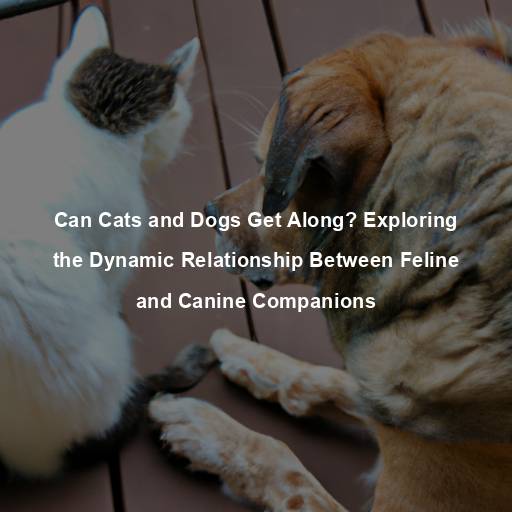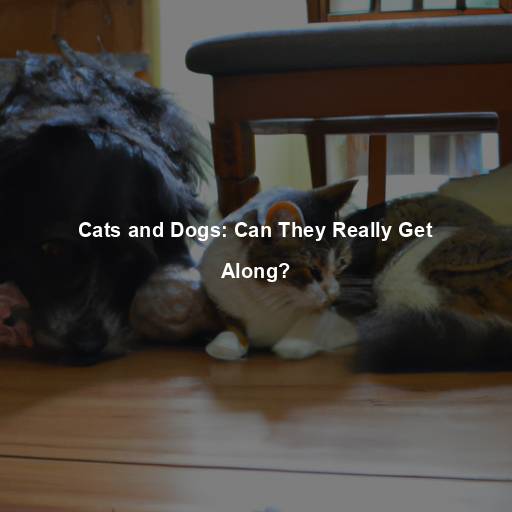Can Cats and Dogs Get Along? Exploring the Dynamic Relationship Between Feline and Canine Companions
Last Updated on October 29, 2023 by Evan
Contents [hide]
- 1 Creating a Safe and Enriching Environment: Meeting Their Needs
- 2 Positive Reinforcement Training: Strengthening the Bond
- 3 Seeking Professional Guidance: When in Doubt
- 3.1 The Role of Professional Animal Behaviorists
- 3.2 Patience, Persistence, and Love
- 3.3 Territorial Tensions: The Battle for Space
- 3.4 Predatory Prey Drive: Managing the Hunter-Prey Dynamic
- 3.5 Communication Barriers: Decoding Feline and Canine Language
- 3.6 Resource Guarding: Managing the Fight for Valuables
- 4 Embracing Individual Differences: Celebrating Unlikely Friendships
- 5 FAQs: Can Cats and Dogs Get Along?
- 5.1 Can cats and dogs get along?
- 5.2 How can I introduce a cat and a dog to each other?
- 5.3 Are there any breed-specific considerations when trying to integrate a cat and a dog?
- 5.4 Should I adopt a cat or a dog first if I want them to get along?
- 5.5 What signs should I look for to know if my cat and dog are getting along?
- 5.6 Can the relationship between a cat and a dog change over time?
- 5.7 Are there any precautions I should take to ensure the safety of my cat and dog?
- 5.8 What if my cat and dog simply cannot get along?
The Importance of Proper
Introducing cats and dogs in a controlled and supervised environment is crucial for a positive first encounter. Keep initial interactions short and gradually increase their duration as they become more comfortable with each other. Use positive reinforcement, such as treats and praise, to reward calm and friendly behavior, reinforcing positive associations.
Creating a Safe and Enriching Environment: Meeting Their Needs
Providing Separate Spaces
Cats and dogs have differing needs when it comes to personal space and territory. To foster a peaceful coexistence, it is essential to provide separate areas where each pet can retreat to when they desire solitude or a break. This can be achieved through designated rooms or by utilizing baby gates or pet enclosures to create physical boundaries.
Vertical Space for Cats
Cats are natural climbers and feel secure when they can observe their surroundings from an elevated position. Providing vertical spaces, such as cat trees or shelves, allows them to fulfill their instinctual need for height and gives them a sense of security.
Exercise and Mental Stimulation
Just like us, our furry friends need a good balance of exercise and mental stimulation to lead fulfilled lives. Whether you have a cat or a dog, keeping them engaged is key. From interactive play sessions to the use of stimulating toys and puzzle feeders, there are numerous ways to combat boredom and steer clear of potential behavior problems. By making sure they get the physical and mental stimulation they need, we can create a harmonious environment where cats and dogs coexist peacefully.
Positive Reinforcement Training: Strengthening the Bond
Training for Cats and Dogs
Positive reinforcement training is a powerful tool in shaping desirable behaviors and strengthening the bond between cats and dogs. By rewarding good behavior, such as calmness and friendly interactions, and redirecting unwanted behaviors, such as chasing or hissing, you can promote a positive and respectful relationship.
Gradual Exposure to Stimuli
Gradual exposure to various stimuli, such as different sounds, scents, and environments, can help desensitize cats and dogs to potential triggers. This can be particularly beneficial if one pet is prone to fear or anxiety. By creating positive associations with previously feared stimuli, you can help build confidence and reduce the likelihood of conflict.
Seeking Professional Guidance: When in Doubt
The Role of Professional Animal Behaviorists
When it comes to cats and dogs, getting them to see eye to eye can sometimes feel like trying to solve a Rubik’s Cube blindfolded. Despite your tireless efforts, their furry feud may persist, leaving you scratching your head and feeling utterly perplexed. But fear not! Seeking the wisdom of a seasoned professional in animal behavior or a certified dog whisperer might just be the key to unraveling this enigmatic dynamic.
Patience, Persistence, and Love
Creating a harmonious relationship between cats and dogs requires patience, persistence, and a whole lot of love. Just like humans, not all cats and dogs will become best friends, but with the right approach, many can learn to coexist amicably. Remember to celebrate small victories and appreciate the unique bond that develops between these two incredible species.
Territorial Tensions: The Battle for Space
Understanding Territorial Instincts
When it comes to claims on territory, cats and dogs are no strangers to the battleground of boundaries. Cats, notorious for their territorial prowess, unleash their scent-marking skills and fiercely protect their domain from unwanted invaders. On the other hand, dogs, known for their adaptability, can’t help but show their territorial side when faced with a newcomer feline encroaching upon their well-established living quarters. However, both species bring their own unique blend of perplexity and burstiness to this age-old struggle for space.
Strategies to Manage Territorial Tensions
To address territorial tensions, it is crucial to provide each pet with their designated areas within the home. This allows them to establish their personal territories and reduces the likelihood of direct confrontations. Additionally, providing multiple resources, such as food and water bowls, litter boxes, and resting areas, can help alleviate competition and minimize stress.
Predatory Prey Drive: Managing the Hunter-Prey Dynamic
Understanding Predatory Instincts
When it comes to the fascinating world of feline behavior, we unravel the mysteries of our beloved cats’ deeply ingrained hunting instincts. While these instincts are usually harmless, they can pose a puzzle for those who share their lives with dogs. We explore the perplexing dynamics that arise when dogs, driven by their own primal instincts, find themselves captivated by the swift movements and unpredictable behavior of their feline housemates.
Strategies to Manage Predatory Prey Drive
Balancing the delicate dance between predator and prey necessitates astute overseeing and ample education. Ensuring feline sanctuaries that exude solace and invulnerability – be it lofty perches or dog-free nooks – plays a pivotal role. Equally important is employing interactive play sessions, harnessing their vigor wisely, to foster constructive pursuits and fortify optimistic connections.
Communication Barriers: Decoding Feline and Canine Language
Understanding Communication Differences
It’s fascinating how cats and dogs have such different languages, leading to a swirling whirlwind of confusion and crossed wires. While dogs are masters at expressing themselves through boisterous body language, enthusiastic barks, and the rhythmic wagging of their tails, cats take a more enigmatic approach. Their communication style is a delicate dance of nuanced expressions, from the tilt of their whiskers to the twitch of an ear, accompanied by a repertoire of vocalizations like purring or hissing.
Strategies to Overcome Communication Barriers
In the realm of fur-miliarity, decoding the enigmatic exchanges between our feline and canine companions is of the utmost importance. By honing our senses and deciphering their cryptic gestures and melodious meows, we can delicately dance on the tightrope of pet cohabitation, averting cataclysmic clashes before they erupt. Ensuring that well-deserved repose sanctuaries are distinct and majestic, and allowing each pampered pet a sweet solace away from the chaos, we can dock the ship of tense ties and untangle the bewilderment.
Resource Guarding: Managing the Fight for Valuables
Understanding Resource Guarding
Resource guarding occurs when a pet perceives a particular item, such as food, toys, or resting areas, as valuable and feels the need to protect it from others. Both cats and dogs may exhibit resource guarding behaviors, which can lead to conflicts and aggression if not managed appropriately.
Strategies to Manage Resource Guarding
Creating a harmonious environment for our furry friends necessitates our undivided attention and conscious effort. By taking proactive steps and exercising thoughtful management, we can prevent the instinctual behavior of resource guarding. Ensuring that each pet has individual access to essential resources like food, water, toys, and their cozy resting areas is essential in promoting a sense of security and peace. Moreover, incorporating positive reinforcement training techniques can further reinforce a cooperative mindset, encouraging our pets to associate the presence of one another with positive experiences and rewarding outcomes.
Embracing Individual Differences: Celebrating Unlikely Friendships
Navigating the intricate dynamics of feline-canine companionship is no easy feat. In the vast tapestry of pet personalities, the compatibility needle can wildly tremble. While some duos stumble upon walls that seem insurmountable, others astound us with their improbable harmonies, like a melodious symphony of paws and whiskers. These awe-inspiring relationships not only warm the cockles of our hearts but serve as a poignant testament to the boundless resilience and camaraderie that sprout amidst diversity in the animal kingdom.
The Power of Positive Associations
Building a harmonious connection between our feline and canine companions is of utmost importance for their coexistence to thrive. By intertwining the presence of these two delightful creatures with joyous encounters like pampering treats, heartfelt praise, and playful bonding sessions, we can ingeniously cultivate a tapestry of positive associations. This thoughtfully crafted approach not only drowns out any lingering inklings of negativity but also sows the seeds of an enduring and captivating bond between our four-legged friends.
Supervised Interactions: Safety First
When it comes to introducing our feline and canine companions, safety is the name of the game. It’s imperative to prioritize a controlled environment by keeping initial interactions under supervision and utilizing physical barriers like baby gates or crates. As they embark on this perplexing journey towards friendship, gradually enhancing the duration and intensity of their interactions will surely lead to a burst of harmonious bonding.
Recognizing Small Victories
In the process of bringing cats and dogs together, it is vital to celebrate even the smallest victories. Whether it’s a shared moment of curiosity, a calm coexistence in the same room, or a gentle nose-to-nose interaction, these small steps indicate progress and lay the foundation for a potentially strong bond.
Seeking Professional Guidance When Needed
While the vast majority of cats and dogs can learn to coexist peacefully, there may be instances where professional guidance is necessary. If conflicts persist, aggression escalates, or if there are concerns about the safety of either pet, seeking the assistance of a professional animal behaviorist or trainer can provide invaluable support and guidance.
FAQs: Can Cats and Dogs Get Along?
Can cats and dogs get along?
The eternal question of whether cats and dogs can coexist peacefully has intrigued pet lovers for ages. While their distinct personalities and social dynamics often lead to contrasting behavior, the possibility of fostering a harmonious bond between these two species exists. With thoughtful introductions and diligent supervision, cats and dogs can embark on a journey towards a mutually beneficial companionship, shattering preconceived notions and proving the power of animal connection.
How can I introduce a cat and a dog to each other?
When it comes to fostering feline and canine camaraderie, taking baby steps is key. Creating a aromatic affair, by allowing the curious sniffing of each other’s bedding or through the strategic deployment of a baby gate, can pave the way for initial interactions. Gently easing them into the visual realm by cautiously granting them peeks from a safe distance will further stoke curiosity. But remember, evolving from those intriguing glimpses to supervised rendezvous calls for a measured approach. Embrace patience, remain steadfast in your consistency, and shower them with positive reinforcement every step of the way.
Are there any breed-specific considerations when trying to integrate a cat and a dog?
While there might be general breed tendencies, each cat or dog is an individual with its own personality. Breed alone cannot predict how well a cat and a dog will get along. It is more important to focus on their individual temperaments, socialization history, and previous experiences with the other species.
Should I adopt a cat or a dog first if I want them to get along?
There is no strict rule about which pet to adopt first. However, it is often easier to introduce a new cat to a home with an established resident dog. Dogs are generally more adaptable and have a greater tendency to form friendships with other animals. It is essential to provide separate spaces for each pet initially and allow them to gradually get acquainted through controlled and monitored interactions.
What signs should I look for to know if my cat and dog are getting along?
As pet owners, we often find ourselves immersed in the mesmerizing dynamics between our furry friends. The subtle art of feline-canine camaraderie is no exception, displaying a plethora of delightful indications that a positive relationship is brewing. One cannot help but marvel at the sight of their relaxed postures and their joint expedition into uncharted corners of the house. The heartwarming sight of them napping in close proximity or engaging in gentle play tugs at our heartstrings, signaling a bond forged in the fires of affection. However, amidst this tapestry of harmony, it is vital to stay vigilant for any signals of unease, bridging the gap between joy and concern, and ensuring a harmonious coexistence for our beloved companions.
Can the relationship between a cat and a dog change over time?
It’s truly remarkable how the dynamics of a cat and dog relationship can evolve and transform in the course of time. At the beginning, when these two creatures with distinct temperaments collide, it can be quite an unpredictable and perplexing situation. Nevertheless, with a dash of patience, a sprinkle of consistency, and a generous dose of positive reinforcement, their interaction begins to unfold in fascinating ways. Some connections remain amicable yet autonomous, while others blossom into an extraordinary bond where they willingly seek each other’s comforting companionship.
Are there any precautions I should take to ensure the safety of my cat and dog?
Creating a harmonious coexistence between our feline and canine companions can sometimes feel like navigating a labyrinth of uncertainty. However, fear not, for cracking the code to a tranquil pet haven is within our grasp. One vital key lies in granting each furry friend their own sanctuary, an escape from the hustle and bustle of the shared living space. By providing them separate areas to rest and regroup, we allow their individuality to shine, diminishing the likelihood of perplexing territorial disputes. Moreover, vigilance is our ally in this enigmatic endeavor. Until we ascertain the compatibility and dynamics of the two, refraining from leaving them alone might just save us from a bewildering scene. Be observant, dear pet lover, and decode the enigmatic language of their bodies. Detect any hints of tension or aggression, and swiftly intervene to restore tranquility and pacify the perplexity that lingers in the air. Remember, education is our majestic sword in this ethereal duel. Ensuring our pets receive consistent training, regular socialization, and proper veterinary care unlocks the secrets to a peaceful and thriving environment, where both the feline and the canine can coexist in contented splendor.
What if my cat and dog simply cannot get along?
Sometimes, no matter how hard we try, it seems that cats and dogs just can’t see eye to eye. It can be disheartening when their once-hopeful interactions turn sour, with aggression and stress taking center stage. In these perplexing situations, it may be necessary to accept the reality and keep them apart for good. Reach out to experienced animal behaviorists or veterinarians who can offer expert advice on how to navigate the challenges and prioritize the well-being of these furry friends.







